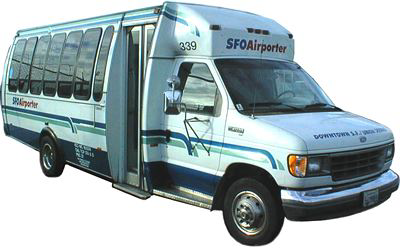No Light Rail in Vancouver!
Light rail costs too much, does too little
People in the transit industry often tell us how fortunate we are that they are spending
billions of dollars of our money each year, because otherwise there would be a lot
more cars on the road and a lot more congestion. This is simply untrue.
In most cities, most transit riders are transit dependent — for one reason or another,
they can’t drive. If government subsidized transit didn’t exist, private operators
would take up the slack and serve these people. The fares might be a little higher
(though not necessarily), and they might not serve some low-density suburbs (where
you see buses that are empty most of the time), but the service would be there. Plus,
anyone who was a “choice” rider — that is, they can drive but would prefer not to
— could use these services too.
If subsidized transit disappeared tomorrow and I were designing a private transit
system for a middle-sized city or urban area, I would follow the taxicab model. Under
this model, the “company” is really just a dispatching call center, while the cabs
are all individually owned. This can easily be scaled up to a transit service by
persuading drivers to buy buses instead of cars.
A full-sized bus costs about $300,000, which is a lot more than a car. But most routes
would not need full-sized buses. Most transit agencies buy buses that are bigger
than they need because most of the cost is covered by “free” federal money. If they
had to spend their own money, they would buy a lot more van-style buses of the sort
you see transporting people from airports to specific hotels.
So, at least to start, many of the routes on my private transit system would be served
by such van-style buses. Some might be smaller, eventually some might be larger.
But owner-operators could easily afford such vans, which cost around $60,000 to $80,000
new and considerably less used.
The U.S. has one example of an entirely private, unsubsidized transit system that
uses this kind of van-bus: the Atlantic City Jitney Association. Each of the 190
buses in the association is owner-operated and follows a fixed route designated by
the association. Fares are reasonable and, unlike most subsidized transit systems,
the buses run 24 hours a day.
My private transit system would start out with a combination of fixed and flexible
routes. A flexible-route bus moves in one general direction — say, to downtown or
some other major job center — but will go out of its way to stop at people’s homes
or other locations to pick people up. The fare for a flexible-route bus would be
more than one that follows a fixed route and only picks up passengers at designated
stops.
Back in the mid-1970s, San Jose tried to use a flexible route system, or “dial-a-ride.”
They bought a bunch of small vans and opened up a call center. From opening day on,
they were swamped with calls — 80,000 people a day wanted rides. The call center
could not handle most of the calls and so most potential riders were disappointed.
In addition, the local taxi company had a franchise on door-to-door service in town,
and they convinced a judge to order the transit agency to pay millions buying their
franchise if the agency persisted in running a dial-a-bus service.
So San Jose gave up on a dial-a-bus in part because, ironically, the demand for it
was too great. Today, the Federal Transit Administration has computer software that
can handle the requests and dispatching, so there is no risk that a call center will
be overwhelmed. But, because of the taxicab lobby, transit agencies restrict their
dial-a-ride services to disabled passengers. Because of low ridership, this makes
it very costly to operate, but if it were opened to more people, those costs would
go down.
The advantage of the taxicab model is that no one has to pay a lot of money up front
to start it up. It would not be a single company; it would be an association of operators.
The dispatching center might consist of a computer and software. Owner-operators
might each buy one van or bus. Those who run on the more successful routes might
buy bigger buses — but, more likely, the association would just run more buses on
those routes. I would overcome the taxi franchise conflict by getting the local taxi
operators to buy into the association.
Most transit agencies have large maintenance centers that have to keep inventories
of parts for every single brand and model of vehicle they operate. Agencies that
run light rail and commuter rail need separate maintenance centers for each one.
The Atlantic City Jitney Association uses just one type of van-bus, which keeps maintenance
costs down. My private transit system would, at least initially, contract out maintenance
to a private repair shop, thus further spreading the costs and minimizing the risk.
There is some minimum size of city below which this model will not work — for example,
any town too small to have a taxi company would certainly be too small for a bus
association. But once that minimum size is reached, this model can scale up to any
size of urban area: from Logan, Utah to New York City.
It is entirely possible that in many cities the bus-association model would actually
provide better service, at little or no more fare, than the subsidized transit systems
we have today. The only reason we don’t see it is that it is hard to compete against
government monopolies.
Scaling Transit, Part 1: Taxis to Buses
Reprinted from The Antiplanner

